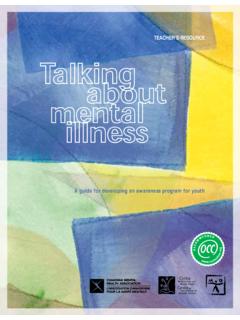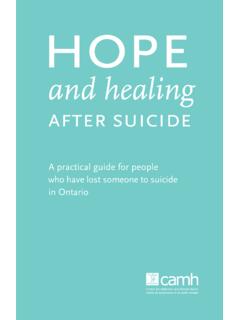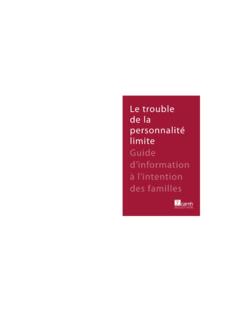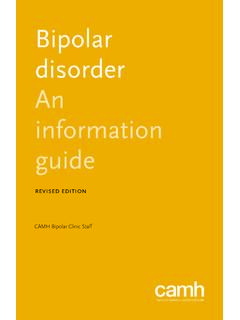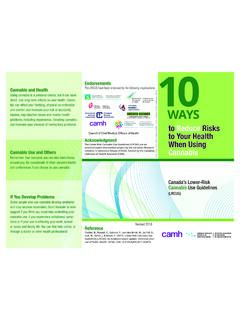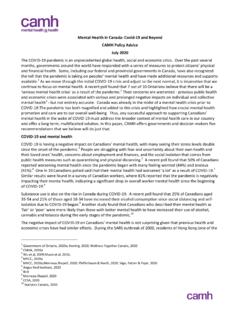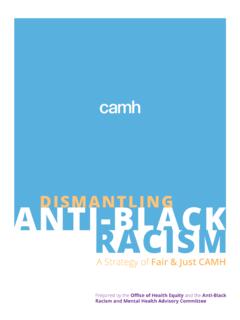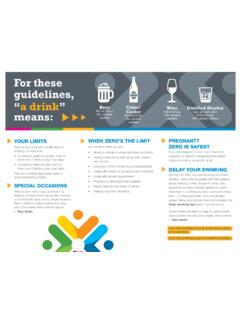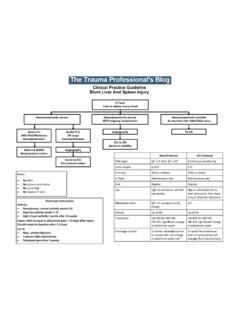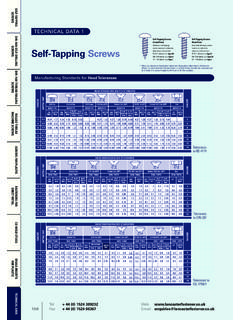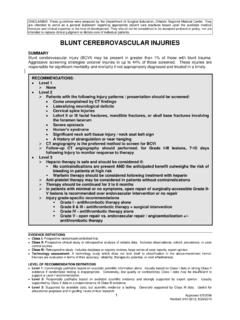Transcription of the Blunt Truth - camh.ca
1 The Blunt Truth Useful tips about safer ways to use cannabis This resource has been developed for youth by youth. We did the boring research so you don't have to! (You're welcome.). You have the choice whether you want to use cannabis* (weed, pot), but you should know that there are different ways of using and some are safer than others. This resource gets down to the Blunt Truth about cannabis, and lets you know what science recommends to help reduce some of the risks to your health and well-being if you do choose to use cannabis. * See back for definitions Why DOES THIS MATTER? No matter how you use cannabis, there are some short- and long-term health risks. The only way to completely avoid all of the risks is to not use cannabis. But we know that's not realistic for everyone! So, if you still want to use, or just want to know more, keep reading to learn about safer ways of using cannabis.
2 What TYPES OF CANNABIS PRODUCTS ARE LESS RISKY? Products that have higher THC (tetrahydrocannabinol). content, the main psychoactive* compound in canna- bis, can be more harmful. These products can lead to short- and long-term problems, such as mental health concerns, dependence or injuries. CBD (cannabidiol), another compound in cannabis, can reduce some negative effects like memory impairment, paranoia and high heart rate. Fewer people experience psychotic symptoms* or other mental health problems when using cannabis that has a higher CBD content. Try to choose products with low THC content, or higher CBD compared to THC content. Watch out for synthetic cannabis products, like K2 or Spice. Synthetics are designed to copy the effects of THC. The contents of most synthetics are unknown, untested and can change from product to product. They can range from being really weak to super strong.
3 Synthetic cannabis use has been linked to seizures, irregular heartbeat, panic attacks, agitation, hallucina- tions and in some cases, death. Try to choose natural cannabis products and avoid synthetics. CBD? K2? Spice? THC? Who SHOULD BE MORE CAREFUL ABOUT USING CANNABIS? Using cannabis when you're younger (and by young we mean teenagers, and definitely younger than 16) can increase the risk of problems with your health, education and social life. (These things are important, trust us!) Also keep in mind that there are specific laws about the legal age of cannabis use in each province, too. Try to delay using cannabis until you're older to lower the risks. Not only can using cannabis impact your own health, it can also harm a fetus or newborn. If you're pregnant or breastfeeding, it's safest to avoid using cannabis. If you or your family has a history of psychosis* or substance use disorder,* your chances of experiencing cannabis-related psychosis, dependence and/or other mental health problems are higher.
4 It's safest to avoid using cannabis if you or your family has a history of psychosis or substance use disorder. When IS IT OKAY FOR ME TO USE CANNABIS? Using cannabis often (daily or almost every day) can affect your health and social life. It can increase your risk of cannabis dependence, changes in brain develop- ment and mental health challenges. If you use often, try to limit your use, such as using only on weekends or once a week. Cannabis use can affect your attention, reaction time and co-ordination. This increases your chance of getting in an accident. Combining alcohol and cannabis can further increase your chances of getting into an accident. You may have heard that you need to wait at least six hours after using cannabis to drive, but it could take much longer for cannabis to clear your system. Some provinces have zero tolerance laws for using cannabis as a new driver, so be sure to do your research based on where you live.
5 If you plan on driving, do not use cannabis, alcohol or other drugs. How CAN I USE MORE SAFELY? Smoking cannabis (in joints, bongs, etc.) is the most harmful way of using cannabis because it affects your lungs. Try vaping instead. You can also eat edibles, but be careful. When you eat edibles, your high is delayed. Pacing yourself can help you avoid what some might call a bad high. Try to avoid smoking cannabis, and instead, try to vape or eat edibles. But remember that no method is entirely risk-free. Some people try to increase their high by deeply inhaling or holding their breath when smoking. Evidence is mixed about whether this method increases your high, but we do know that more toxic material is absorbed into your lungs when you smoke this way, and it can cause lung problems. Try to avoid deeply inhaling or holding your breath when smoking. De nitions Cannabis: Also known as marijuana (grass, weed, pot, dope, ganja), hashish (hash), dabs and hash oil (weed oil, honey oil).
6 Cannabis can be made into edibles either by cooking it into foods, such as brownies, or making it into a drink. Psychosis: A mental state where people have trouble knowing what's real and what's not. Psychoactive: Drugs, like cannabis or alcohol, that can change the way that a person thinks, acts or feels. Substance use disorder: People use alcohol and other drugs for many reasons. When people crave a drug, lose control of how much or how often they use, feel that they have to use the drug and use despite negative consequences, their drug use may be problematic and considered a substance use disorder. If you're interested in finding out more or if you think you need help controlling your cannabis use, please visit the Canadian Research Initiative in Substance Misuse Ontario node website for a list of resources you might find helpful. This youth education resource was developed by the Margaret and Wallace McCain Centre for Child, Youth & Family Mental Health's Youth Engagement Initiative at CAMH, based on Canada's Lower-Risk Cannabis Use Guidelines (LRCUG).
7 The LRCUG are an evidence-based substance use intervention initiative, supported by the Canadian Research Initiative in Substance Misuse (CRISM). 5638f/09-2018 P6514 All rights reserved. CAMH, 2018. Canada's Lower-Risk Cannabis Use Guidelines. #TheBluntTruth What DO YOU CALL A HIGH LIZARD? A mariguana Source reference: Fischer, B., Russell, C., Sabioni, P., van den Brink, W., Le Foll, B., Hall, W. et al. (2017). Lower-risk cannabis use guidelines (LRCUG): An evidence-based update. American Journal of Public Health, 107(8). DOI.
